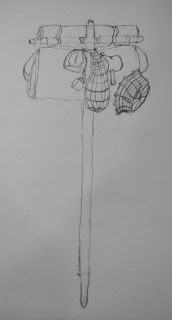Now, bear in mind, that the text in this post is subject to change. You are getting a live version, not a fixed snapshot of a work in progress.
I had a long day today, so things are very ruff. You'll find typos and mixed-up sentences, I am sure. Up until 15 minutes ago, I didn't realize that I had one character was in two places at once. While based off of something I would use in my high magic D&D campaigns, I typically like to keep time and space fixed so I don't drive my players or myself nuts.
This started with an idea for a D&D campaign, it has morphed into something more. Perhaps it doesn't reproduce D&D exactly, but it rhymes with it. I have a cast of characters like a party. Each character has a role like a class, but I changed things up willy-nilly to fit the story.
The whole setting is based on Roman culture but displaced in time and space. If it was set in Rome, it would be about 200 years after the Fall of the Western Roman Empire. However, it is not set in Rome or even Europe. If you have ever been north of Buffalo or Rochester in New York, you will notice the similarities in the terrain.
Although this section is an external character study of Justo and Gerwinder, Serena and Rolf's powers are highlighted in the extreme.
Serena has a lot of shoutouts to Disney's Encanto, particularly the character Luisa Madrigal. She would be a divisive woman to ancient Romans. She behaves as if she is the actual wife of Hercules, which is very dangerous scenario in ancient times. She is a free woman with no duties or obligations to the rule of law because her husband cannot be taken to task or court. For the purposes of this story, there is a general belief that Hercules is an absent demi-god meaning that Serena can roll as she sees fit.
I also use her to describe realistic clothing worn by Roman women, topped off with a fantastic expy Girdle or Belt of Giant Strength.
Rolf doesn't know he is god touched. He is a priest of Mercury and you'll notice some of the trappings of a D&D cleric. He can turn undead and cannot use a bladed weapon. He knows the first, but not the second. His magic is thematic to Mercury, so he can cast haste on himself and others. He can probably do this once per day.
Gerwinder's flight depicts Traveller's "slow drug" in action.
It is an oddity that Serena is Rolf, Sarah and Leon's sister while also having the cult title of "Sister". I hope that isn't too confusing. The multiple references to "cults" is in line with the ancient meaning of the word, which lacks the current negative implications. It is all about the rites and ceremonies in practicing religion. In this particular case, Serena is celebrating Hercules by not being present for his feast day, an event that excluded women.
Since Heracleia takes place in late July or early August and the wheat harvest is anywhere from July to mid-September, we have the implication that Sister Serena is a bit of a globe trotter.
Geoff is Rolf, Leon and Serena's brother-in-law. He is a fighter-farmer, which is something every legionary and auxiliary aspired to be. He is an earnest citizen of his new culture. He is probably an example of a lawful good alignment in action.
Leon is the opposite of Geoff in every way, being landed and noble in a very simplistic way. He is the oldest son in a large family, of which we have only met a handful. Don't be fooled by Leon's actions in this section. He is a prime example of lawful or neutral evil thinking in action. He is putting weapons in the hands of people enslaved by Father. What a wonderful way to inherit young.













